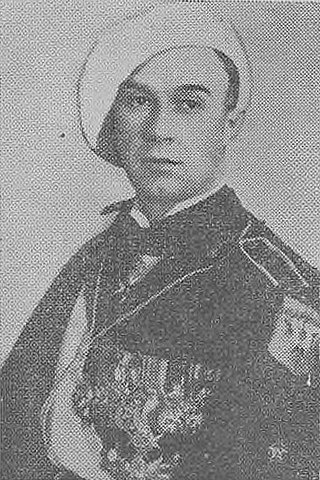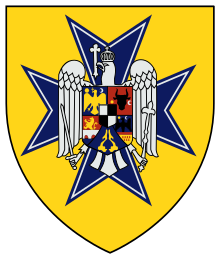The 41 județe and the municipality of Bucharest comprise the official administrative divisions of Romania. They also represent the European Union' s NUTS-3 geocode statistical subdivision scheme of Romania.

The Kingdom of Romania was a constitutional monarchy that existed from 13 March (O.S.) / 25 March 1881 with the crowning of prince Karl of Hohenzollern-Sigmaringen as King Carol I, until 1947 with the abdication of King Michael I and the Romanian parliament's proclamation of the Romanian People's Republic.
The Kingdom of Romania, under the rule of King Carol II, was initially a neutral country in World War II. However, Fascist political forces, especially the Iron Guard, rose in popularity and power, urging an alliance with Nazi Germany and its allies. As the military fortunes of Romania's two main guarantors of territorial integrity—France and Britain—crumbled in the Fall of France, the government of Romania turned to Germany in hopes of a similar guarantee, unaware that Germany, in the supplementary protocol to the 1939 Molotov–Ribbentrop Pact, had already granted its blessing to Soviet claims on Romanian territory.

The term Greater Romania usually refers to the borders of the Kingdom of Romania in the interwar period, achieved after the Great Union. It also refers to a pan-nationalist idea.

Mihai Antonescu was a Romanian politician who served as Deputy Prime Minister and Foreign Minister during World War II, executed in 1946 as a war criminal.

The Moldavian Democratic Republic, also known as the Moldavian Republic or Moldavian People's Republic, was a state proclaimed on 15 December [O.S. 2 December] 1917 by the Sfatul Țării of Bessarabia, elected in October–November 1917 following the February Revolution and the start of the disintegration of the Russian Empire.

Cercetașii României is the primary national Scouting organization of Romania. Founded in 1913, it became a member of the World Organization of the Scout Movement (WOSM) in 1993.

Ion I. Nistor was a Romanian historian and politician. He was a titular member of the Romanian Academy from 1915 and a professor at the universities of Cernăuți and Bucharest, while also serving as Minister of State for Bukovina, Minister of Public Works, Minister of Labor, and Minister of Religious Affairs and the Arts with a number of governments from 1918 to 1940.

Between 28 June and 3 July 1940, the Soviet Union occupied Bessarabia and Northern Bukovina, following an ultimatum made to Romania on 26 June 1940 that threatened the use of force. Those regions, with a total area of 50,762 km2 (19,599 sq mi) and a population of 3,776,309 inhabitants, were incorporated into the Soviet Union. On October 26, 1940, six Romanian islands on the Chilia branch of the Danube, with an area of 23.75 km2 (9.17 sq mi), were also occupied by the Soviet Army.

The National Legionary State was a totalitarian fascist regime which governed Romania for five months, from 14 September 1940 until its official dissolution on 14 February 1941. The regime was led by General Ion Antonescu in partnership with the Iron Guard, the Romanian ultra-nationalist, and anti-communist organization. Though the Iron Guard had been in the Romanian Government since 28 June 1940, on 14 September it achieved dominance, leading to the proclamation of the National Legionary State.
Anti-Romanian sentiment, also known as Romanophobia is hostility, hatred towards, or prejudice against Romanians as an ethnic, linguistic, religious, or perceived ethnic group, and it can range from personal feelings of hatred to institutionalized, violent persecution.

Visarion Puiu was a metropolitan bishop of the Romanian Orthodox Church. During World War II, at a time when Romania was an ally of Nazi Germany, he served as the leading Eastern Orthodox clergyman in occupied Transnistria, a territory where several hundred thousand Jews were murdered. In August 1944, when Romania switched sides, he took refuge in Nazi Germany.

The National Renaissance Front was a Romanian political party created by King Carol II in 1938 as the single monopoly party of government following his decision to ban all other political parties and suspend the 1923 Constitution, and the passing of the 1938 Constitution of Romania. It was the party of Prime Ministers Armand Călinescu, Gheorghe Argeșanu, Constantin Argetoianu, Gheorghe Tătărescu, and Ion Gigurtu, whose regimes were associated with corporatism and antisemitism. Largely reflecting Carol's own political choices, the FRN was the last of several attempts to counter the popularity of the fascist and antisemitic Iron Guard. In mid-1940, Carol reorganized the FRN into the more radical Party of the Nation, designed as a "totalitarian unity party". The party's anthem was "Pe-al nostru steag e scris Unire". It effectively ceased to function the following year when the Parliament of Romania was dissolved.

Nicolae Ciupercă was a Romanian general, born in Râmnicu Sărat. He served during World War I and World War II under the command of Alexandru Averescu and then Ion Antonescu, but would retire from a military life in 1941 over strategy disagreements with Antonescu. He also served as Minister of National Defense in 1938–1939.

Ion Gigurtu was a far-right Romanian politician, Land Forces officer, engineer and industrialist who served a brief term as Prime Minister from 4 July to 4 September 1940, under the personal regime of King Carol II. A specialist in mining and veteran of both the Second Balkan War and World War I, he made a fortune in interwar Greater Romania. Gigurtu began his career in politics with the People's Party (PP) and the National Agrarian Party, moving closer to the far right during the 1930s, and serving as Minister of Industry and Commerce in the cabinet of Octavian Goga. Shortly after the start of World War II, Gigurtu was affiliated with King Carol's National Renaissance Front, serving as Public Works and Communications Minister and Foreign Minister under Premier Gheorghe Tătărescu, before the territorial losses incurred by Romania in front of the Soviet Union propelled him as Tătărescu's replacement.

Elena Alistar-Romanescu was a Bessarabian physician and politician who was part of Sfatul Țării from Bessarabia.

The National Socialist Party or Steel Shield was a mimetic Nazi political party, active in Romania during the early 1930s. It was led by Colonel Ștefan Tătărescu, the brother of Gheorghe Tătărescu, and existed around the newspaper Crez Nou. One of several far-right factions competing unsuccessfully against the Iron Guard for support, the group made little headway, and existed at times as a satellite of the National-Christian Defense League.

Carol II, the King of Romania from 1930 to 1940, was the focus of a cult of personality for much of the latter part of his reign. The cult peaked with the suspension of the 1923 Constitution of Romania and the establishment of a "royal dictatorship" in 1938. His personality cult shared some features with Communist leader Nicolae Ceaușescu's own personality cult that took root three decades later. Indeed, there have been a number of suggestions that Ceaușescu was inspired by Carol's cult.
The Socialist Peasants' Party was a short-lived political party in Romania, presided over by the academic Mihai Ralea. Created nominally in 1938 but dissolved soon after, it reemerged during World War II. A clandestine group, it opposed the fascist regime of Ion Antonescu, although its own roots were planted in authoritarian politics. Looking to the Soviet Union for inspiration, the PSȚ was cultivated by the Romanian Communist Party (PCdR), and comprised a faction of radicalized social democrats, under Lothar Rădăceanu.

General Teofil Gh. Sidorovici was one of the commanders of the Straja Țării (Watchmen), a paramilitary youth organization in the Kingdom of Romania, created in 1935, and Minister of National Propaganda in the sixth Gheorghe Tătărescu cabinet, after the resignation of Constantin C. Giurescu.
















